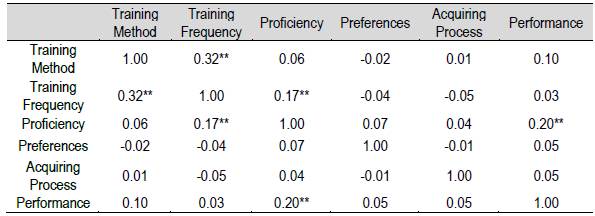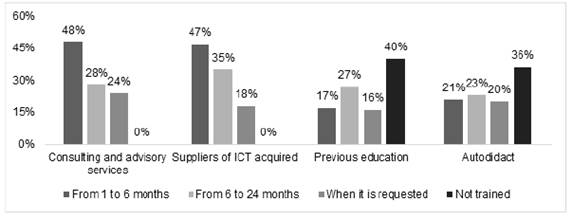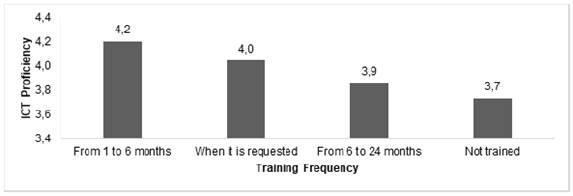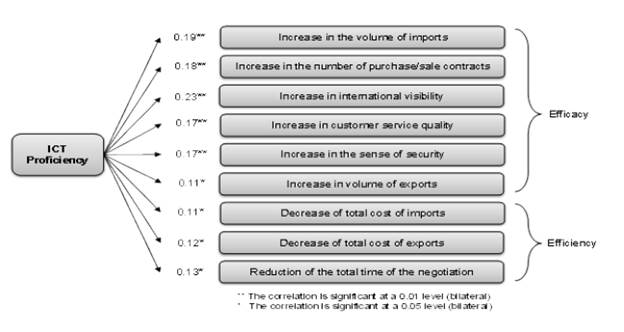Introduction
The Pacific Alliance is an economic integration initiative that intends to promote the commercial relations of Chile, Colombia, Mexico and Peru as member countries. In this sense the main goal of this agreement is to promote free movement of goods, services and capital; all of this encouraging economic development and competitiveness, reaching higher levels of welfare and equality, and achieving the consolidation of an economic and political bloc focused on the Asia-Pacific market (Alianza del Pacífico, 2016; Baena, Castaño & Tabares, 2016).
According to Flemes and Castro (2016), the Pacific Alliance represents a regional project in which some Latin American countries seek to play a leading role in the dynamics of international relations, in addition to gaining economic influence in the region, as Brazil has done. However, Guelar (2013) argues that the Pacific Alliance is not just an attempt to counteract the influence of other countries in the region or other established trade blocs as the Mercado Común del Sur (Mercosur), but rather a real attempt to improve the relations and opportunities offered by the Asian market.
Clearly, this economic integration initiative represents one of the two most important economic integrations in Latin America (Seatzu, 2015), becoming an influential trade bloc to counteract the economic hegemony achieved in this region by some countries such as the United States and China. The Pacific Alliance has a population of 217 million people with an average gross domestic product (GDP) per capita of US$9,910 in 2015 (Alianza del Pacífico, 2016), and presents interesting growth indicators in recent years, motivating the member countries to consolidate their economic and political relations (Aranda, 2014). Therefore, this kind of initiatives can bring synergies to generate better wages, higher productivity, and increase the countries' GDP (García-Belenguer & Santos, 2011).
However, to achieve the purposes of the Pacific Alliance it is necessary to facilitate free movement of goods, services, capital and people, generating development in the member economies (Maya, 2016). In this regard, this trade bloc has been accomplishing interesting results since it has reduced the custom tariffs of products in 92% of the tariff universe; i.e. in all those products that are subject to customs duties within this market (Ferrón & Erichiello, 2014). Similarly, other important developments within this trade bloc have to do with the elimination of visas in the member states (De Hubeñak, 2015).
Regarding the development of countries and regions, ICT drive technological advancement and decrease economic gaps between industrialized and developing countries through increased productivity in organizations such small and medium-sized enterprises (SMEs). Even, the born globals, represent in some countries a high rate of their transactions, considering their fast internationalization approach and their participation in international businesses (Steinmueller, 2001; Londoño, Vélez & Rojas, 2015; Tabares, Álvarez & Urbano, 2016). Thereby, companies carrying out international negotiation processes for exporting and importing goods and services can access a variety of benefits offered by ICT, such as systematically solving internal problems, generating synergies, and a greater capacity to adapt and innovate in global markets (Cano & Baena, 2013; Baena, Cano, Pérez & Jarrin, 2014; Parida et al., 2016).
To access these benefits, it is necessary that companies reach adequate appropriation of ICT in their international negotiation processes, and according to the Technology Acceptance Model (TAM), this depends on the perceived usefulness and perceived ease of use of ICT (Davis, 1989; Yong, 2004). Thus, the real benefits of ICT for helping users to perform their jobs better and easily will be the main determinants to adopt ICT into the international negotiation process (Davis, 1989). In fact, Cano and Baena (2015a) demonstrate direct relationships between international negotiation performance and the use of ICT through the volume of exports and imports, the number of purchase/sales contracts, and the total time and costs of the international negotiation process.
Similarly, Fernandez-Menendez et al. (2009) claim that the use of ICT in negotiation processes for international sales can facilitate transactions between companies, minimizing the use of resources. Also, it could be said that there is a positive relationship between ICT adoption and perceived performance in internationalization processes, although the impact is not always immediate due to the wide variety of ICT that support the stages of international negotiations (Baena, Cano & Pérez 2015; Cano & Baena 2017). According to this, the benefits obtained with the use of ICT differ depending on the technology applied in each company for the management of information and communication (Cano and Baena, 2015b).
Hence, this article aims to examine the relationships between ICT appropriation and international negotiation performance within the framework of the member countries of the Pacific Alliance. For this purpose, it was established, above-named, some theoretical foundations about the role of this trade bloc, and analyzes the influence of ICT on international negotiation processes. Then, the methodology section introduces a model of relationships between ICT appropriation and international negotiation performance, validating it with a field study of several companies from the Pacific Alliance countries. In the results section the proposed model is refined, and some details about the relationships between appropriation variables and performance are explained. Finally, the article presents the main conclusions and contributions of this research.
Materials and Methods
To identify the relationship between ICT appropriation variables and performance indicators for the international business negotiations processes in companies of the Pacific Alliance, 402 telephone surveys were conducted with chiefs or managers of the international trade department in each company. Based on the information gathered, 18 companies did not comply with complete information on each of the aspects analyzed in this research, resulting in a sample of 384 companies. Table 1 shows the characterization of the companies of the sample, classifying them by country and size, and identifying that 49% of them are medium-sized enterprises, 26% are large enterprises and 25% are small enterprises. It can also be observed that most of the sample size is concentrated in Mexico with 65% of the total companies, followed by Chile, Colombia and Peru with 16%, 11% and 9%, respectively.
Company participation by country is the result of the stratification of the sample according to the total number of companies that import and/or export goods and services in the Pacific Alliance. Several questions related to ICT appropriation were addressed in the chosen companies, including variables such as the procedure for acquiring ICT, proficiency in the use of ICT, methods and frequency of ICT training, and preferences in the way of conducting international trading negotiations. Similarly, some questions were related to the performance achieved in international negotiations with ICT, emphasizing on indicators such as total time and cost in negotiation, international visibility, customer service quality, sense of security, amount of purchase/sales contracts, and cost and volume of imports and/or exports.
Based on the information found, the study intends to statistically identify relationships within the appropriation variables and performance indicators of the international business negotiation process. Figure 1 exhibits these relationships under the assumption that some ICT appropriation variables directly affect each other, and that some ICT appropriation variables directly affect performance perception.

Source: Author’s elaboration
Figure 1 Relations between appropriation variables and international negotiation performance
In particular, the model suggests that there is a direct relationship between the method of training in ICT and how often these trainings are offered to employees; furthermore, these two variables directly affect the level of mastery of ICT by employees. Also, the proposed model states that the level of mastery of ICT affects the preferences to negotiate face to face or with the use of ICT and vice versa; and that both the level of mastery of ICT and the negotiation preferences affect the perception of performance of international negotiation supported by ICT. Lastly, the model assumes that the process of ICT acquisition influences the performance of international negotiation. It is important to clarify that the international negotiation performance indicator mentioned in Figure 1 is the result of an arithmetic average of the performance indicators mentioned above.
Results
According to the information collected in the field study, and using the SPSS 19 software, a statistical analysis of bilateral Pearson correlation validates the relationships between the variables mentioned in Figure 1, obtaining the results in Table 2.
Table 2 Correlations between variables of appropriation and international negotiation performance

** The correlation is significant at a 0.01 level (bilateral)
Source: Author's elaboration
Table 2 presents bilateral or bivariate Pearson correlations that represent the linear association between each pair of variables, where the absolute value of the coefficient represents the strength of the relation and the sign represents the direction of the relation. These kinds of correlations differ from partial correlations, since partial correlations identify the influence of a third variable on the relationship of two variables. In this case, we are interested in corroborating the strength of the relationships between the variables previously stipulated in Figure 1, whereby bivariate correlations are the most adequate. In addition, Table 2 shows that there are positive and highly significant correlations between training method and training frequency of ICT for international business negotiations, between training frequency and proficiency of ICT, and between proficiency of ICT and international negotiation performance. Based on these results, Figure 2 depicts the variables proposed in the model in Figure 1 that present significant correlations. Therefore, the analysis excludes the process of acquiring technologies and preferences because they do not present a significant relationship with the other ICT appropriation variables or with international negotiation performance.

Source: Author's elaboration
Figure 2 Significant relationships between appropriation variables and international negotiation performance
The results show that the appropriation variables that have significant relationships with each other and with international negotiation performance are those that directly affect employee skills, abilities and attitudes towards the use of ICT. The variables analyzed are those that directly affect the perceived usefulness and ease of use of ICT, which are the pillars of ICT appropriation according to the TAM (Davis, 1989; Yong, 2004; Venkatesh & Bala, 2008). For that reason, in companies of the Pacific Alliance, the training method affects the frequency of ICT training, which implies that training frequency must be established according to the ICT training method.
Regarding this point, Figure 3 shows that ICT training is more often required when employees receive training by advisory and consulting services, and by ICT suppliers; and this indicates that training methods relying on external personnel of the company require high frequency of use. This is because the source of knowledge and expertise in ICT lies in external staff, and companies need to hire these external services more frequently to update their employees and ensure that they adopt the knowledge and skills necessary to manage ICT. For companies in which education previously received by employees (skills acquired in universities, colleges, courses, among others) and the self-taught method are the main training method, they tend not to train employees or provide trainings with frequencies between 6-24 months. Companies in which these training methods predominate could assume that employees have previously acquired skills in the use of ICT or employees receive training by their own and improve aspects that they consider relevant.

Source: Author's elaboration
Figure 3 Training method and training frequency on ICT for international negotiations
Furthermore, based on the correlation analysis of Table 2, it is evident that companies in the Pacific Alliance that train their employees more frequently develop a higher level of proficiency of ICT in their staff. Figure 4 shows that companies training employees in ICT with a frequency between 1 to 6 months have an average mastery level of 4.2 on a scale from 1 to 5, which represents a satisfactory mastery level. A satisfactory level of mastery in ICT is also obtained on average (4.0 on a scale from 1 to 5) when ICT trainings correspond to a particular situation of the company (at the request of employees, when a technology is upgraded, an employee is hired, among others). Otherwise, when employees do not receive training they present on average the lowest level of mastery of ICT, because the company does not provide these services to their employees or because employees do not request these services from the company.

Source: Author's elaboration
Figure 4 Training frequency and ICT proficiency for international negotiations
The results of the correlation analysis also show that companies with a higher ICT proficiency in their employees are those who perceive greater improvements in international negotiation performance. Figure 5 exposes a significant difference among companies whose employees have an outstanding mastery (rating equal to 5) and a poor mastery of ICT (rating equal to 1); this corresponds approximately to a 35 % difference in the perception of performance improvement. This scenario represents an opportunity for companies to improve ICT proficiency in their employees, generating a better negotiation performance.

Source: Author's elaboration
Figure 5 ICT proficiency and international negotiation performance improvement
Table 3 shows the level of ICT mastery and the perceived performance of international negotiation using ICT in each country of the Pacific Alliance. It is worth mentioning that the average level of mastery of ICT is similar in each country and it has a satisfactory rating, with opportunities to improve it to harness the benefits offered by ICT. Regarding perception of performance using ICT, Mexico presents a performance improvement of 58%, followed by Peru and Chile with 51%, respectively, and Colombia with 48%. Broadly, the Pacific Alliance companies perceive that ICT improve international negotiation performance by 55%, which motivates these countries to increase the use of ICT and their implementation to enhance competitiveness in this important process.
Table 3 Proficiency and international negotiation performance in the Pacific Alliance

Source: Author's elaboration
To detail the relationship between ICT proficiency and international negotiation performance, a correlation analysis with each of the performance indicators is made, obtaining significant correlations for all indicators, except for reduction of the total cost in the negotiation process. Figure 6 shows that the performance indicators with highly significant correlations with mastery of ICT are: increase in the volume of imports, increase in the number of purchase/sales contracts, increase in international visibility, increase in customer service quality, and increase in the sense of security. Similarly, Figure 6 shows that the performance indicators showing significant correlations with ICT mastery are: increase in export volume, decrease of total import and export costs, and total time reduction in the negotiation process. These indicators, except for the increase in export volume, refer to efficiency because they reflect the use of resources such as time and cost (Botello & Pedraza, 2014; Cano & Baena, 2015a; Cano & Baena, 2016; Cano & Baena, 2016b). Thus, they confirm that appropriation of ICT significantly supports international negotiation performance in terms of efficiency and efficacy; and particularly if employees receive regular training in the use of ICT, they will enhance their ICT proficiency, which will reflect an improvement in the performance of the negotiation process.
The analysis showed that the ICT appropriation variables and performance indicators had correlations with each other. It was also found that the most commonly used processes to acquire ICT for international negotiation in Pacific Alliance companies are: acquiring technologies based on the needs and requirements of the company (58%), calling on a vendor or technology consultant (15%), and acquiring technologies that are widely used in the business environment (11%). These results evidence that most companies do a proper ICT appropriation process, and that it corresponds to the real needs of the company; thereby companies can solve their operative challenges more properly. However, it is striking that more than one tenth of the companies acquire ICT only because they are fashionable or because they are widely used in the business environment, without really knowing whether these technologies satisfy the real needs of the negotiation processes of each company.
Concerning the preferences to conduct international negotiations, which is another ICT appropriation variable without significant correlations, it is noted that 57% of the companies prefer to rely on ICT for international negotiations, while 43% prefer to do this process face-to-face. This reflects that a higher proportion of companies in the Pacific Alliance prefer to perform their international negotiation processes supported by ICT, which is expected to increase over time as these technologies generate positive results in performance indicators such as those listed in Figure 6.
Finally, the field study identifies that for the countries of the Pacific Alliance it is perceived that ICT improves international negotiation performance by approximately 55%, which motivates them to improve their use and increase their implementation to enhance competitiveness of this important process. As a result, companies must strive to continue improving ICT proficiency and then take advantage of the benefits offered by these technologies in international negotiations.
Discussions
According to Hutchings & Suri (2015), the Pacific Alliance is one of the most important economic integration processes in Latin America region, because this set of countries offers a great potential integrating a 216 million consumers market with remarkable purchasing power and many business opportunities for their enterprises.
From that point of view, the ICT are playing an essential role in international business by offering opportunities to enterprises, including SMEs, for reaching new business boundaries due to the new opportunities that these technologies offers nowadays (Pauleen & Yoong, 2001).
In addition, the results show a remarkable trend where enterprises are interested in appropriating ICT for the international business process due all their benefits related to efficiency and efficacy. Likewise, ICT provides the easiest way to attain innovative alternatives for internal operations within companies, especially for SMEs (Botello & Pedraza, 2014; Cano & Baena, 2016; Cano & Baena, 2016b).
Additionally, the evidence shows that the use of specific ICT provide many benefits and impacts on several dimensions of business performance, taking into account both direct and indirect effects as well as short and long-term effects depending on the use of these resources (Bayo-Moriones, Billón & Lera-López, 2013; Fernandez-Menendez et al., 2009).
Indeed, according to Cano & Baena (2015a), there is a model called ICT Market Performance Model for International Negotiation (ICTPEMOIN), which analyzes the relation of the ICT use and the business market performance. Therefore, our results related to the Pacific Alliance confirm that companies using ICT are capable to generate efficiency and efficacy, thus, increasing the international market performance and achieving new contracts for the international sale. In this sense, this study reveals a relationship between ICT training method, ICT training frequency, and ICT proficiency, and how these variables impacts the international negotiation performance.
Conclusions
According to the proposed model of ICT appropriation and international negotiation performance for the companies of the Pacific Alliance, this research determined that the ICT training method affects the frequency at which these trainings are provided. Similarly, if employee training is regular, they achieve a higher proficiency in these technologies, which generates greater international negotiation performance in terms of efficiency and efficacy.
This research identifies that the acquisition of ICT and preferences of use of ICT in international negotiations do not directly influence other variables of appropriation or performance indicators. The study also suggests focusing efforts on improving the method and frequency of training to enhance ICT proficiency in employees; this will directly affect the perceived usefulness and ease of use of ICT, which form the pillars of ICT appropriation as stated by the TAM.
This article defines that, among the countries of the Pacific Alliance, ICT proficiency for international negotiations is similar; however, the perception of performance of this process is greater in Mexico than in Peru, Chile and Colombia. It suggests that Peru, Chile and Colombia could obtain benefits through training in these technologies due to the benefits they offer regarding the use of resources and achievement of business goals. Therefore, for companies from the Pacific Alliance, this research recommends improving skills in the use of ICT for the international negotiation process, and taking advantage of the features in the available technologies. All this represents an opportunity to enhance international negotiation performance and to consolidate the Pacific Alliance as a trade bloc that facilitates and supports the exchange of goods and services through exports and imports.
















